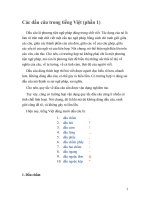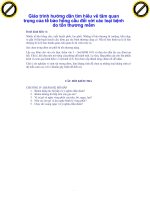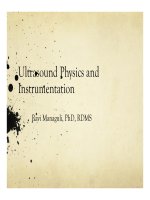Các loại đầu dò Siêu Âm (Ultrasound Transducers)
Bạn đang xem bản rút gọn của tài liệu. Xem và tải ngay bản đầy đủ của tài liệu tại đây (1.23 MB, 49 trang )
Ultrasound Transducers
Ravi Managuli
Last Week
Ultrasound Wave Parameters
Frequency, Wavelength, Period
Intensity, Power
Pulse length, Pulse duration, Axial resolution
Ultrasound wave propagation
Reflection, Scattering, Absorption
Ultrasound interaction with the media
Reflection, Transmission Refraction
Spatial pulse length
Spatial pulse duration
System
Beamformer
Media
(organ system)
Transducer
ADC
Digital
Delay
Summer
Signal/Image
Processor
Display
Clinical
Transducer : Many types
Responsible for axial, lateral and
elevation resolution
Signal strength
Quality of the reflected signal
Types of transducers
Curvilinear array
Phased array
Linear array
3D array
Mechanical or fully
sampled
Transducer
A device that converts one form of energy
into another form of energy
US transducers:
Converts electrical energy into acoustic energy (sound waes)
during transmission
Coverts acoustic energy to electrical energy during reception
Conversion is accomplished through the piezoelectric effect
Ultrasound Transducers
Major parts of a transducer
Piezoelectric (PZT) elements – functional component of the transducer :
Frequency
Matching layer – reduces acoustic impedance b/w PZT & tissue
Backing (damping) block – absorbs backwards directed (stray) U/S from
housing
Bandwidth (pulse length)
c.f. Bushberg, et al. The Essential Physics
of Medical Imaging, 2nd ed., p. 484.
Ultrasound Transducer
Elevation direction (y)
Lateral direction (x)
Axial direction (z)
Axial Resolution
Cannot resolve : Reflections overlap
Resolve
Spatial pulse length
Axial resolution: Half of spatial pulse length
• Inversely proportion to the frequency
•
Axial resolution of 12 MHz probe is better than 5 MHz
Spatialpulselength l * N c ´ N
AR =
=
=
2
2
2f
Bandwidth
Bandwidth is the useful range of contiguous frequencies over which
transducer can operate.
Ultrasound transducer typically have multiple frequencies
For example
C5-1 transducer means : It has frequencies ranging from 1 to 5 MHz
L12-5 means frequencies ranging from 5 to 12 MHz
Bandwidth
Bandwidth : Inversely proportional to number of cycles present in a
pulse
(little dampening)
Low BW
(heavy dampening)
High BW
Bandwidth is related to spatial pulse length
Large bandwidth Small pulse length Better axial resolution
BW-mode
Narrow bandwidth Long pulse length Worse axial resolution
Color-Doppler
Lateral Resolution
Ability to resolve two structure laterally
Best in the near zone
Depends upon the transducer width
•
Focal point
Elevation Resolution (Slice Thickness)
Elevation resolution is the dimension perpendicular to the image plane
• Depends on the transducer element height
• Axial resolution is better than lateral resolution
• Later resolution is better than elevation resolution
Ultrasound Transducer
Frequency
Sound speed in transducer
2thickness
wavelength = Thickness * 2
Smaller the thickness Higher frequency
Backing Material
Backing materials (Also called damping) reduces oscillations of
the transducer element
Acoustic impedance is same as PZT. So easy transmission through
PZT
Absorber
Electrical
Connector
Housing
Aluminum-filled epoxy.
PZT
Matching
Lens
Backing (Damping) Material
Reduces oscillations of the transducer element
Reduces the number of cycles
Reduced spatial pulse length
High Bandwidth
Better for axial resolution
Reduced sensitivity
Low-level RETURNED signals from tissue may not
produce image
Mainly used for PW
Ultrasound Transducer
Signal strength
V
Intensity generated is proportional to V2
EZ
Z
Piezoelectric material
l
IV
2
Wave Parameters
Parameters of waves
Speed
Frequency
Period
Wavelength
Amplitude
Power
Intensity
Pulse length
Pulse duration
Bandwidth
Thickness
Voltage
Damping material
Matching Layer
Matching layer sits between PZT and skin
Reduces the impedance mismatch between transducer and skin
Otherwise most of the ultrasound would be reflected back from skin
Increases the efficiency of sound energy transfer
Impedance of PZT > Matching layer > Gel Impedance > Skin
Thickness of this layer:
wavelength/4
Absorber
Electrical
Connector
Housing
PZT
Matching
Lens
Ultrasound Transducer
Elevational direction (y)?
Lateral direction (x)?
Axial resolution (z) :
Depends upon thickness of transducer,
Lateral Resolution
Lateral resolution depends transducer diameter Decides the
beam path
lateral resolution :
1
D : Diameter
d
D D f
• Lateral resolution depends upon the beam diameter
• Best at the focal point
• Diameter/2
Beam Diameter vs.
Depth
Near Zone)
D2 f D2
Near zone z
4 c 4
Far zone
Lateral resolution at face of transducer
Transducer diameter
Lateral resolution at Focus is smallest Best lateral resolution
Transducer Diameter/2
Lateral resolutiom in far field, when far zone = near zone
Transducer Diameter
Focus
D2 f D2
Near zone z
4 c 4
For a 5 MHz, 2cm probe:
Near zone z = 32 cm ! Too far
To improve lateral resolution focusing is performed: Two types
Fixed focusing
External focusing
Internal focusing
Electronic focusing
Phased array focusing
Fixed Focusing
External focusing
Curved acoustic lens
Increased curvature increases
focusing
Internal focusing
Curved crystal
Increased curvature
Increases focusing
Still limitations of fixed focus
Cannot be controlled for different depth
Focused
Unfocused
Curved Lens
Electronic Focusing
Electronically focus the beam
User can control the location of the focus
Only possible with the multiple element transducer
For both transmit focusing and Receive focusing
Focal point
Focused beam
td n
Electronic delays
Target
Delays









